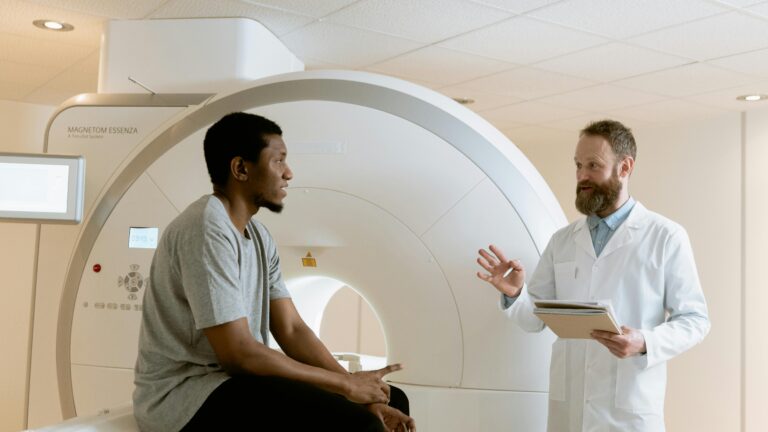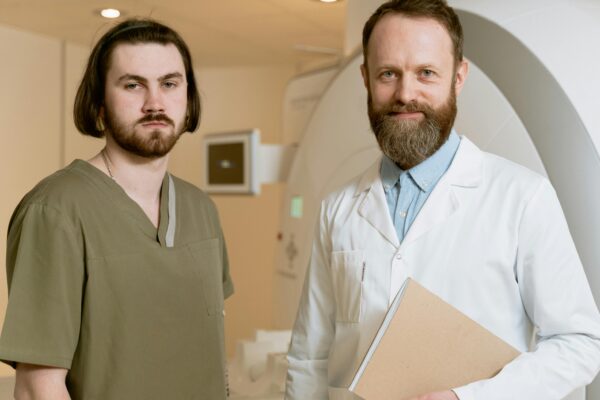- Understanding Prostate Radiation Therapy
- Types of Prostate Radiation Therapy
- Who Needs Prostate Radiation Therapy?
- The Prostate Radiation Therapy Process
- Side Effects of Prostate Radiation Therapy
- How to Minimize Side Effects
- Comparing Radiation Therapy to Other Treatments
- Is Radiation Therapy Right for You?
- Final Thoughts: Beating Prostate Cancer Like a Boss
- Studies and Research on Prostate Radiation Therapy
- FAQs: Prostate Radiation Therapy
- Question: How effective is radiation therapy for prostate cancer?
- Question: What are the common side effects of prostate radiation therapy?
- Question: How long does prostate radiation therapy take?
- Question: Does radiation therapy for prostate cancer cause pain?
- Question: Can I work while undergoing prostate radiation therapy?
- Question: Will I be radioactive after prostate radiation therapy?
- Question: Which is better, surgery or radiation therapy for prostate cancer?
- Question: How should I prepare for prostate radiation therapy?
- Question: Can I have sex during prostate radiation therapy?
- Question: How often should I get PSA tests after radiation therapy?
Understanding Prostate Radiation Therapy
Prostate radiation therapy is one of the most effective treatments for prostate cancer, using high-energy rays to destroy cancerous cells. If you or someone you know is facing this treatment, buckle up—because we’re diving deep into everything you need to know, from how it works to side effects and recovery. No fluff, just straight-up useful information to help you handle this like a warrior.
Types of Prostate Radiation Therapy
Radiation therapy comes in two main forms, each with its own strengths and weaknesses. Here’s what you need to know:
1. External Beam Radiation Therapy (EBRT)
This method uses a high-energy X-ray machine to zap cancer cells from outside your body. It’s painless and doesn’t require surgery. EBRT is usually done five days a week for several weeks, giving your healthy cells time to recover between sessions.
Types of EBRT:
- Intensity-Modulated Radiation Therapy (IMRT): The most precise form of EBRT, IMRT adjusts radiation beams to focus on the tumor while avoiding healthy tissues.
- Stereotactic Body Radiation Therapy (SBRT): A more intense, shorter-duration treatment that uses pinpoint accuracy.
- Proton Therapy: Instead of X-rays, protons deliver radiation with minimal damage to nearby tissues. It’s promising but not always available.
2. Brachytherapy (Internal Radiation Therapy)
This involves implanting tiny radioactive seeds directly into the prostate, giving off targeted radiation over time. It’s ideal for early-stage prostate cancer and has fewer side effects than EBRT.
Types of Brachytherapy:
- Low-Dose Rate (LDR) Brachytherapy: Radioactive seeds stay in place permanently, slowly releasing radiation.
- High-Dose Rate (HDR) Brachytherapy: Temporary implants that deliver a stronger dose of radiation in fewer sessions.
Who Needs Prostate Radiation Therapy?
Radiation therapy is a go-to treatment for:
✔️ Early-stage prostate cancer, as a primary treatment.
✔️ Post-surgery patients, to kill any remaining cancer cells.
✔️ Advanced prostate cancer, combined with hormone therapy.
✔️ Recurring prostate cancer, if surgery wasn’t effective.
The Prostate Radiation Therapy Process
1. Planning the Treatment (Simulation)
Before you start radiation, doctors do a CT scan or MRI to map out the exact location of your prostate. You may get tiny tattoos to help guide the radiation beams (don’t worry, it’s not the kind you’ll regret later).
2. The Treatment Sessions
- For EBRT, you lie on a table while the machine delivers targeted radiation. Each session takes about 10-20 minutes, and you can go home afterward.
- For brachytherapy, tiny radioactive pellets are inserted into your prostate under anesthesia. This is typically a one-time procedure.
3. Post-Treatment and Recovery
- After EBRT, you may feel a bit fatigued, but there’s no downtime—you can usually go back to work the same day.
- After brachytherapy, you’ll need to avoid prolonged close contact with pregnant women and young kids for a while due to radiation exposure.
Side Effects of Prostate Radiation Therapy
Radiation therapy is powerful, but it does come with some side effects. Let’s break them down:
Short-Term Side Effects:
🚽 Urinary Issues: You might experience frequent urination, a weak stream, or a burning sensation. Drinking plenty of water can help.
🍽️ Bowel Changes: Some men experience diarrhea, rectal irritation, or mild bleeding. Cutting back on spicy foods and caffeine can reduce discomfort.
💪 Fatigue: A common side effect, but regular exercise can help combat this.
Long-Term Side Effects:
🔥 Erectile Dysfunction (ED): Radiation can damage the nerves responsible for erections. ED meds like Viagra or Cialis can help.
🚾 Urinary Incontinence: While rare, some men develop long-term bladder control issues.
💩 Bowel Changes: A small percentage of men experience long-term rectal discomfort.
How to Minimize Side Effects
🛑 Stay Hydrated: Drinking water helps flush out radiation effects from your body.
🥦 Eat a Prostate-Friendly Diet: Focus on fiber-rich foods, lean proteins, and antioxidant-rich fruits. Avoid processed junk.
🏋️ Exercise Regularly: Even light walks can help maintain energy levels and support recovery.
🩺 Follow Up With Your Doctor: Regular PSA tests ensure the cancer stays in check.
Comparing Radiation Therapy to Other Treatments
| Treatment | Pros | Cons |
|---|---|---|
| Radiation Therapy | Non-invasive, effective, preserves prostate | Possible ED, urinary issues, fatigue |
| Surgery (Prostatectomy) | Removes cancer completely | Longer recovery, risk of incontinence/ED |
| Hormone Therapy | Slows cancer growth | Can cause weight gain, mood swings, reduced libido |
| Active Surveillance | No immediate side effects | Cancer may spread if not monitored properly |
Is Radiation Therapy Right for You?
Choosing prostate radiation therapy depends on your age, health, cancer stage, and personal preference. It’s effective, non-invasive, and widely recommended, especially for early to mid-stage prostate cancer. However, every man’s case is different, so discussing your options with your doctor is crucial.
Final Thoughts: Beating Prostate Cancer Like a Boss
Look, prostate cancer isn’t a death sentence, and radiation therapy is one of the best weapons we have against it. Yes, there are side effects, but with the right lifestyle adjustments and medical support, you can handle this like a pro.
Stay positive, keep moving, and take control of your health—because you’ve got this! 💪
Studies and Research on Prostate Radiation Therapy
For those who want to dive deeper into the science behind prostate radiation therapy, here are some credible studies and research papers that provide valuable insights into its effectiveness, side effects, and long-term outcomes.
1. Effectiveness of Radiation Therapy for Prostate Cancer
- “Long-Term Outcomes of Radiation Therapy in Prostate Cancer Patients” – Published in The Lancet Oncology, this study analyzes survival rates and recurrence risks in patients who underwent external beam radiation therapy.
🔗 Read the study - “Comparison of Radiation Therapy and Surgery for Localized Prostate Cancer” – A comprehensive study from The New England Journal of Medicine comparing radiation therapy outcomes with radical prostatectomy.
🔗 Read the study
2. Side Effects and Quality of Life Post-Treatment
- “Long-Term Urinary and Sexual Function After Prostate Cancer Radiation Therapy” – This JAMA Oncology study evaluates how radiation affects urinary continence and erectile function over time.
🔗 Read the study - “Fatigue and Recovery Patterns in Prostate Cancer Patients After Radiation Therapy” – A study from Cancer Research Journal discussing common side effects and strategies for improving post-treatment recovery.
🔗 Read the study
3. Advances in Radiation Therapy Techniques
- “Proton vs. X-Ray Radiation Therapy: A Comparative Study” – Research published in The Journal of Clinical Oncology highlighting the advantages and limitations of proton therapy.
🔗 Read the study - “The Role of Stereotactic Body Radiation Therapy (SBRT) in Prostate Cancer Treatment” – A study from Radiotherapy & Oncology Journal detailing how SBRT provides high-precision treatment with fewer sessions.
🔗 Read the study
4. Radiation Therapy for Recurrent Prostate Cancer
- “Salvage Radiation Therapy for Recurrent Prostate Cancer: A Meta-Analysis” – This study from Urology Journal explores how radiation therapy can be used effectively after initial treatment failure.
🔗 Read the study - “Radiation Therapy vs. Hormone Therapy for Recurring Prostate Cancer” – Published in European Urology, this paper compares the effectiveness of different treatment approaches for recurrence.
🔗 Read the study
These studies provide scientifically-backed insights into how radiation therapy is used for treating prostate cancer, helping you make informed decisions based on real data. Always consult with your doctor to see which approach best suits your condition.
FAQs: Prostate Radiation Therapy
Question: How effective is radiation therapy for prostate cancer?
Radiation therapy is highly effective for early-stage prostate cancer, with success rates comparable to surgery. Many patients remain cancer-free for 10 years or more after treatment.
Question: What are the common side effects of prostate radiation therapy?
Common side effects include urinary frequency, bowel changes such as diarrhea, erectile dysfunction, and fatigue. Most symptoms improve over time.
Question: How long does prostate radiation therapy take?
External beam radiation therapy typically lasts 4-9 weeks with daily sessions, while brachytherapy (internal radiation) may be a one-time procedure or involve a few short sessions.
Question: Does radiation therapy for prostate cancer cause pain?
No, the treatment itself is painless. Some discomfort may come from lying still during the procedure, but the radiation does not cause pain.
Question: Can I work while undergoing prostate radiation therapy?
Yes, most patients can continue working during treatment. Some experience fatigue, so adjusting work hours or taking short breaks may help.
Question: Will I be radioactive after prostate radiation therapy?
If you undergo external beam radiation therapy, you will not be radioactive. However, if you receive brachytherapy with permanent seed implants, you may emit low levels of radiation for a few months.
Question: Which is better, surgery or radiation therapy for prostate cancer?
Both treatments have similar survival rates. Surgery removes the prostate but carries higher risks of incontinence and erectile dysfunction, while radiation therapy is non-invasive but may cause long-term bowel and urinary issues.
Question: How should I prepare for prostate radiation therapy?
Preparation may include dietary guidelines, staying hydrated, and sometimes undergoing hormone therapy to shrink the tumor before radiation.
Question: Can I have sex during prostate radiation therapy?
Yes, but temporary erectile dysfunction or reduced libido may occur. If undergoing brachytherapy, ask your doctor about safety precautions.
Question: How often should I get PSA tests after radiation therapy?
Doctors usually recommend PSA blood tests every 3-6 months for the first five years to monitor for any signs of cancer recurrence.
Disclaimer: This article is for informational purposes only and should not be considered medical advice. Always consult with a qualified healthcare professional before making decisions about your health.





